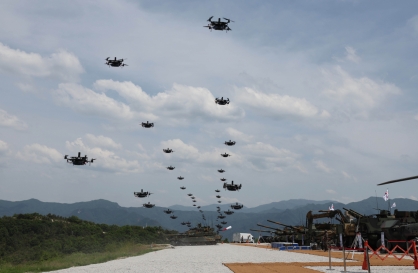[Editorial] Pyongyang's intentions
Instigation of conflict within the South has always been the North‘s key strategy
By Korea HeraldPublished : Jan. 8, 2024 - 05:30
South Korea's Joint Chiefs of Staff said North Korea fired some 200 artillery shells into waters near the western sea border on Friday morning, prompting the South to order civilians on the nearby islands of Yeonpyeongdo and Baengnyeongdo to take shelter. The North fired another 60 rounds Saturday afternoon, and over 90 rounds Sunday afternoon.
As the shells fell into the maritime buffer zone north of the Northern Limit Line, no damage was done to South Korean civilians or military.
On Friday, the South responded by firing over 400 rounds of artillery into waters south of the NLL from 3 p.m. It was the first time the South’s military fired shells near the western sea border in six years. The South did not take action against the North’s artillery fire on Saturday, as it had not been aimed toward the South.
On Sunday, North Korean leader Kim Jong-un's powerful sister Kim Yo-jong claimed in a statement carried by the North's state media that the North had detonated explosives simulating the sound of 130 mm coastal artillery the previous day. The South's Defense Ministry dismissed her claim as "a low-level psychological warfare" directed at undermining confidence in the South's military.
The latest military provocation by the North is aimed at raising tensions, confirming that it scrapped in November an inter-Korean military accord signed on Sept. 19, 2018, under which artillery firing and naval drills were banned in the buffer zone. North Korea is also rebuilding guard posts inside the Demilitarized Zone, which it had demolished under the 2018 deal.
Since signing the pact six years ago, the North has violated it 16 times by firing shells into the maritime buffer zone, according to the South’s Defense Ministry. The South’s military did not fire back, and sought to conform to the pact by moving its K-9 self-propelled howitzers from Yeonpyeongdo and Baengnyeongdo to Pocheon in Gyeonggi Province or Pohang in North Gyeongsang Province for firing exercises.
The NLL has been a major flashpoint between the two Koreas since 1999. Naval skirmishes referred to as the first and second battles of Yeonpyeongdo took place in 1999 and 2002, followed by an exchange of fire between an intruding North Korean patrol boat and the South’s Navy vessels near Daecheongdo in 2009; the North’s torpedo attack that sunk the South Korean Navy corvette Cheonan in March 2010; and the North’s artillery firing that killed four South Koreans including two civilians on Yeonpyeongdo in November 2010.
The South’s military and intelligence authorities expect the North to engage in “high-intensity” provocations targeting the South’s general election in April and the US presidential election in November. They could be cyberterrorist attacks, hacking of ballot counting systems, testing of tactical nuclear warheads or something else. The North attacked the Cheonan, killing 46 sailors, about two months ahead of the local elections in 2010. Increasing military tensions to instigate conflict within the South by making South Koreans blame the Seoul government has been Pyongyang’s unwavering strategy towards the South since the Korean War.
So has diverting North Koreans’ attention outward as they suffer from deepening economic troubles and witness signs of another hereditary power succession.
On Friday, Pyongyang’s state media released photos of Kim Jong-un and his 10-year-old daughter Ju-ae touring a factory that produces mobile launchers for intercontinental ballistic missiles. The South’s spy agency now sees Ju-ae as the most likely candidate to succeed Kim.
The South’s Unification Minister Kim Yung-ho said in a televised interview on KBS Saturday that should Donald Trump get reelected as the US president and officially acknowledge North Korea as a nuclear state, South Korea and Japan “will have no choice but to develop their own nuclear weapons.”
South Koreans have long grown numb to the North’s repeated firing of missiles and artillery rounds, but we should not forget that the Kim regime is capable of attacking South Koreans as it has in the past. The South’s military, intelligence authorities and state-funded think tanks should also do a better job of preparing against all possible situations regarding the North.
-
Articles by Korea Herald



















